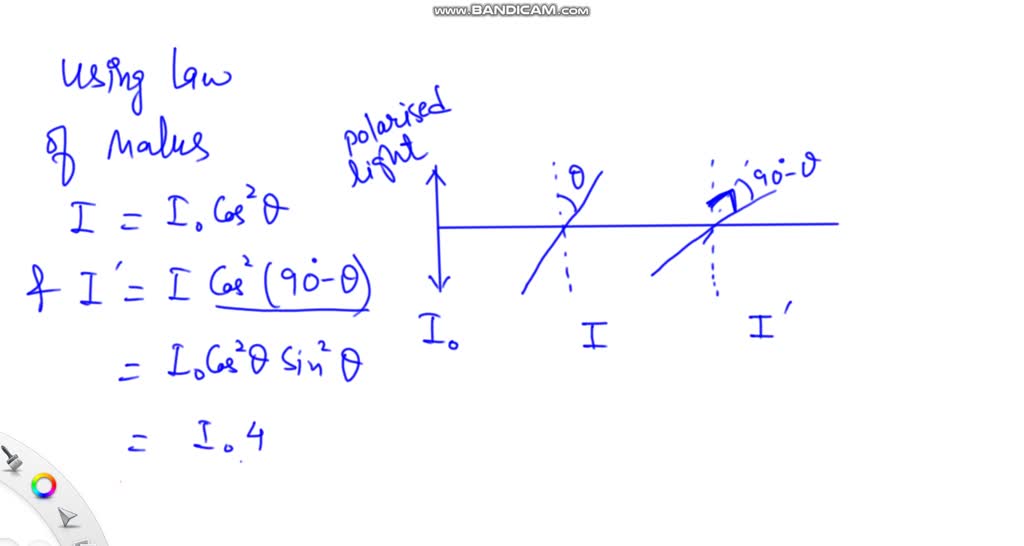Have you ever noticed how sunlight reflecting off a calm lake seems to shimmer and change color? Or how your sunglasses reduce glare from the road on a bright day? These curious phenomena are due to a fascinating property of light called polarization. But how does this apply to light reflecting off surfaces like floors or tables? Does this ordinary reflection also lead to polarization? Let’s delve into the world of light, polarization, and explore whether reflection off everyday surfaces alters the nature of light.

Image: www.numerade.com
Polarization refers to the direction in which light waves vibrate. Imagine light as a wave traveling through space, with its electric and magnetic fields oscillating in a particular direction. When light is unpolarized, these vibrations occur randomly in all directions. However, when light is polarized, the vibrations are confined to a specific plane. This is like a rope being shaken up and down, creating waves that move only in a vertical direction. Polarized light has a special property that allows for manipulation, affecting how it interacts with the world around us.
The Science of Polarization
Understanding how light gets polarized is key to answering our question. Think of a light wave like a rope. When you shake the rope up and down, you create vertically polarized waves. When you shake it side to side, you create horizontally polarized waves. Now, imagine a special filter that allows only vertically polarized waves to pass through. This filter absorbs the horizontally polarized waves while letting the vertically polarized ones pass through. This is how polarizing filters work!
Reflection and Polarization
When light hits a surface, it undergoes reflection, where some of its energy bounces back. The reflected light can be polarized, but it depends on the angle of incidence and the material of the surface. Consider a smooth surface like a mirror. When light strikes it at a specific angle called the Brewster’s angle, the reflected light becomes completely polarized. This means that all the reflected light waves vibrate in the same plane. This is the reason why polarized sunglasses block glare from horizontal surfaces like roads and water, as the reflected light from these surfaces is predominantly horizontally polarized.
The Case of Floors and Tables
The reflection off floors and tables is not as straightforward as a perfectly smooth mirror. These surfaces are often rough and irregular, scattering light in different directions. This lack of a uniform smooth surface means that light is not reflected at a specific angle, and therefore, there’s no uniform polarization of the reflected light. However, some degree of polarization may still occur, but it won’t be as pronounced as the reflection off a mirror or a calm water surface.

Image: www.chegg.com
Factors Affecting Polarization
The extent to which light gets polarized when reflecting off a surface is influenced by various factors:
- Angle of Incidence: The angle at which light strikes the surface plays a crucial role. As mentioned earlier, the Brewster’s angle is a critical point where the reflected light becomes fully polarized. For angles different from Brewster’s angle, the reflected light will be partially polarized.
- Material of the Surface: The material of the surface also affects the polarization. Surfaces like glass or water have a higher degree of polarization compared to rough surfaces like wood or concrete.
- Surface Roughness: A smooth surface will reflect light at a specific angle, resulting in polarization. Rough surfaces, on the other hand, scatter light, reducing the extent of polarization in the reflected light.
The Importance of Polarization
Polarization might seem like a subtle phenomenon, but it has a profound impact on our world:
- Vision and Glare: Polarized sunglasses reduce glare by blocking horizontally polarized light, which is abundant in reflected sunlight from surfaces like roads and water. This makes our vision clearer and eliminates eye strain.
- Photography and Vision Enhancement: Polarizing filters are used in photography to reduce reflections from glass or water, allowing for more detailed images of objects beneath the surface. Polarized light can also be used to increase contrast and enhance the sharpness of images.
- Liquid Crystal Displays (LCDs): The screens of our laptops, phones, and televisions use polarized light to control the passage of light through the liquid crystals, enabling us to enjoy sharp and clear visuals.
- Scientific Research: Polarized light plays a crucial role in scientific research, particularly in fields like microscopy, astronomy, and material science, where it helps in analyzing and understanding various phenomena.
Practical Tips
Here are a few practical tips that highlight the application of polarization:
- Sunglasses: Always opt for polarized sunglasses, especially when driving or engaging in activities near water. They significantly reduce glare and enhance visual clarity.
- Photography: Experiment with polarizing filters in your photography to capture stunning landscapes, water reflections, and enhance the contrast of images.
- Screen Protection: Use polarized screen protectors to minimize glare from your laptop, phone, or tablet, enhancing readability and eye comfort.
Is Light Reflected Off The Floor Or A Table Polarized
Conclusion
While the reflection off floors and tables might not result in the same level of polarization as a smooth mirror, it still plays a role in influencing how light interacts with these surfaces. Understanding the principles of polarization can deepen our appreciation for the diverse ways light interacts with the world around us. From reducing glare to enhancing vision and revolutionizing screen technology, polarization is a fascinating and powerful phenomenon that continues to shape our lives in countless ways. So the next time you notice that shimmer of light off a wooden table or the glare from a window, remember that you are witnessing the subtle yet powerful effects of polarized light.






